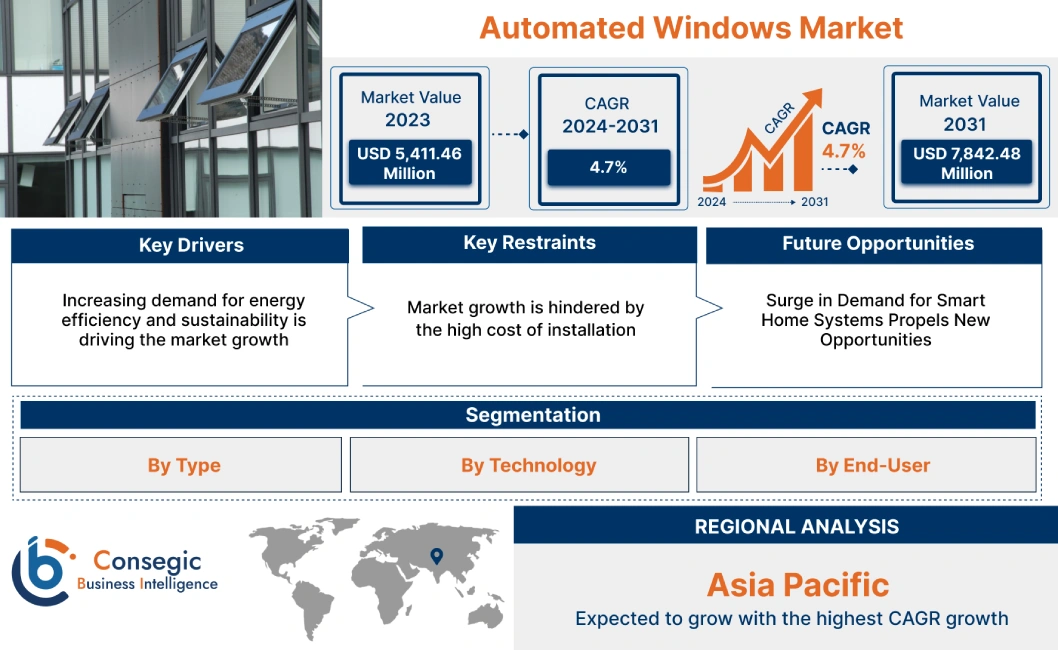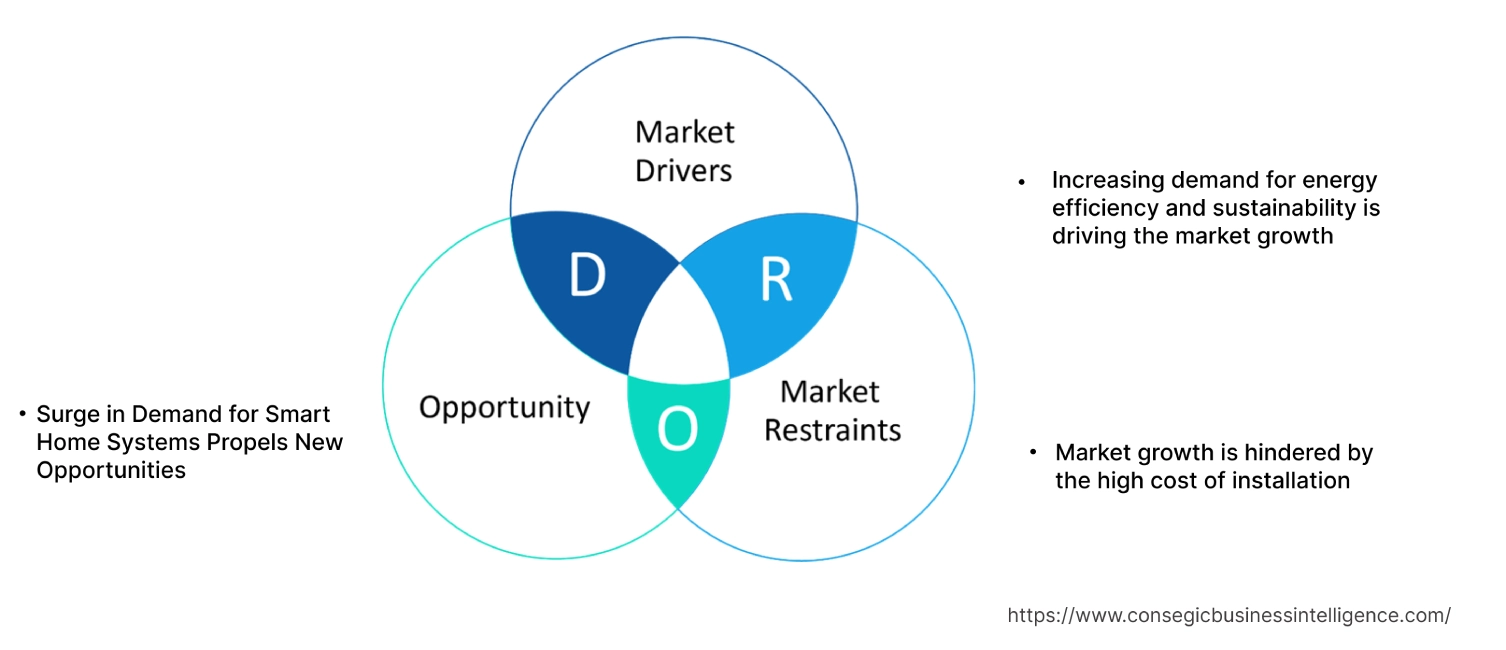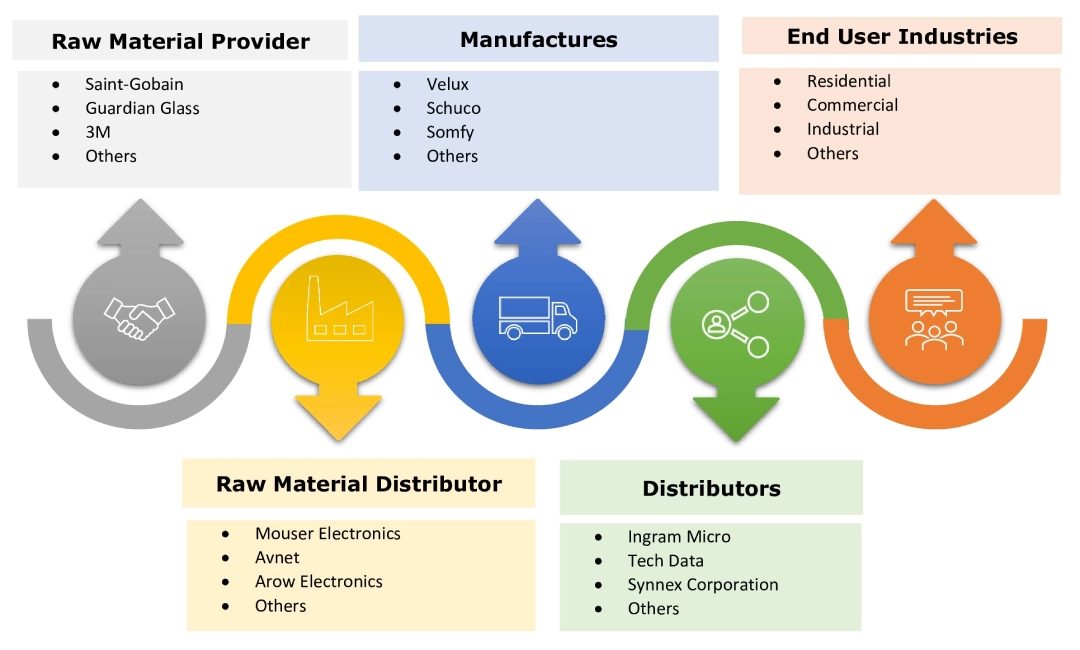Automated Windows Market Size:
Automated Windows Market size is estimated to reach over USD 7,831.41 Million by 2032 from a value of USD 5,528.82 Million in 2024 and is projected to grow by USD 5,678.58 Million in 2025, growing at a CAGR of 4.73% from 2025 to 2032.
Automated Windows Market Scope & Overview:
Automating windows involve using various tools and techniques to perform tasks automatically, saving time and effort without manual intervention. Also, the systems are controlled via remote controls, sensors, voice commands, or integration with smart home systems in turn driving the automated windows industry. Additionally, the windows are integrated with building automation systems, allowing for functions including temperature control, natural light optimization, and ventilation management, contributing to energy savings and improved comfort. Moreover, the benefits of these systems include convenience enhancement and energy efficiency in the residential, commercial, and industrial sectors which in turn is boosting the automated windows market growth. Further, the aforementioned benefits of these windows are major determinants for increasing their deployment in the residential sector which in turn is boosting the automated windows market demand..
Automated Windows Market Insights:
Key Drivers:
Rising Focus on Energy Efficiency and Sustainability is Boosting Market Growth for Automated Windows
The rising concerns about energy conservation and sustainability are driving the automated windows market growth. Additionally, key factors such as increasing utility costs, government regulations promoting energy-efficient practices, and the growing demand for sustainable building certifications are driving the automated windows market demand. Further, the rise of green building projects encourages the use of windows that significantly reduce energy consumption, promoting sustainability goals which in turn is boosting the market growth.
- For instance, in December 2021, View, Inc. introduced smart windows installation at Bozeman Yellowstone International Airport (BZN) which automatically adjusts tint based on external light conditions, reducing energy usage by minimizing the need for artificial lighting and air conditioning.
Therefore, the rising concerns about energy conservation and sustainability are driving the adoption of smart windows, in turn proliferating the growth of the market.
Key Restraints :
High Installation Cost and Compatibility Issues are Restraining the Market Growth
The initial investment required is substantial, encompassing the windows and the integration of control systems. This high cost acts as a barrier to widespread adoption, particularly in residential applications where budget constraints are more pronounced in turn hindering the automated windows market expansion. Further, ongoing maintenance and potential repair expenses associated with these windows contribute to industry restraint. Furthermore, the compatibility and integration issues with existing home infrastructure, such as older electrical systems and limited connectivity, are a major hurdle for the growth of the market.
Therefore, the high installation costs as well as compatibility and integration issues are hindering the automated windows market expansion.
Future Opportunities :
Surging Adoption of Smart Home Automation Technology is Expected to Promote Potential Opportunities for Market Growth
The increased consumer demand for convenience, energy efficiency, and security which are facilitated by smart home automation systems is fueling the automated windows market opportunities. Additionally, the need for automated windows that can be controlled remotely and integrated into these systems is expected to promote potential prospects for market progress. Further, factors such as increased connectivity, IoT integration, and rising awareness of the benefits of automation are driving the market evolution.
- For instance, in August 2023, Crestron Electronics launched Crestron Home OS 4, a smart home system featuring customization, interoperability, home control using a remote, touchscreen keypad or mobile device, security, and privacy.
Hence, the increasing need for smart home systems is anticipated to increase the utilization in turn promoting prospects for automated windows market opportunities during the forecast period.
Automated Windows Market Segmental Analysis :
By Type:
Based on the type, the market is bifurcated into fully automatic and semi-automatic.
Trends in the Type:
- The trend toward rising need for customizable features is driving the adoption of a semi-automatic segment which in turn is boosting the market progress.
- The trend towards touchless operation is growing particularly in public and commercial sectors is driving the adoption of fully automated windows.
Semi-Automatic segment accounted for the largest revenue share in the year 2024.
- Semi-automatic windows combine manual operation with basic automation features, including motorized opening and closing controlled by switches or remotes.
- Additionally, the windows allow more customization according to individual preferences and specific building requirements.
- Further, the key factors driving the adoption of semi-automatic segment include cost-effectiveness, ease of installation, energy efficiency, and scalability.
- For instance, in March 2023, VELUX unveiled Roof Window, a semi-automated system, crafted from recycled materials, that effectively decreases their embodied carbon footprint in contrast to regular VELUX blinds.
- Thus, according to the automated windows market analysis, customization and energy efficiency of semi-automated windows are driving the market progress.
The fully Automatic segment is anticipated to register the fastest CAGR during the forecast period.
- Fully automatic windows are equipped with advanced mechanisms that allow windows to open, close, and function based on various sensors, timers, or automated controls.
- Additionally, the windows include advanced sensors for temperature, humidity, and sunlight, allowing them to adjust automatically based on environmental conditions.
- Further, the rising demand for home automation systems is driving the fully automatic segment which in turn is boosting the market progress.
- For instance, in February 2022, Lutron Electronics launched Serena Smart Architectural Honeycomb Shades, with smart windows shade that adjust based on sunlight and temperature. It also works seamlessly with smart home ecosystems.
- Therefore, according to the automated windows market analysis, the rising demand for home automation systems is anticipated to boost the market during the forecast period.
By Technology:
Based on the technology the market is segmented into sensor-based, remote-controlled, and voice-controlled.
Trends in the Technology:
- The trend toward the adoption of sensor-based systems to optimize energy usage includes adjusting windows to enhance natural ventilation and reduce heating and cooling costs.
- The rise in smart home automation, offering convenience, energy efficiency, and improved comfort is driving the adoption of remote-controlled technology which in turn drives the automated windows market trends.
Remote-controlled technology accounted for the largest revenue share of 46.21% in the year 2024.
- Remote-controlled windows offer ease of use by allowing you to adjust window settings through remotes or smartphones.
- Additionally, the key advantages of adopting remote-controlled technology in windows include increased flexibility and productivity, cost savings, enhanced security, and others.
- Further, windows are increasingly being integrated with smart home ecosystems, enhancing functionality and user experience which in turn boosts the automated windows market size.
- For instance, in July 2022, Somfy launched Tahoma Gateway, a system providing remote control for windows and shades. The solution integrates seamlessly with smart home technologies including Control 4, Crestron, and others.
- Thus, as per the market analysis, the integration with smart home ecosystems, enhancing functionality and user experience is driving the market progress.
Voice-controlled technology is anticipated to register the fastest CAGR during the forecast period.
- Voice control offers a convenient, hands-free way to operate and adjust windows settings.
- Additionally, the voice-controlled technology provides an intuitive and natural way to interact with automated systems, enhancing user experience.
- Further, the proliferation of IoT technologies is driving the demand for voice-controlled technologies which in turn boosts the automated windows market size.
- Therefore, as per the market analysis, the proliferation of IoT technologies is anticipated to boost the market during the forecast period.
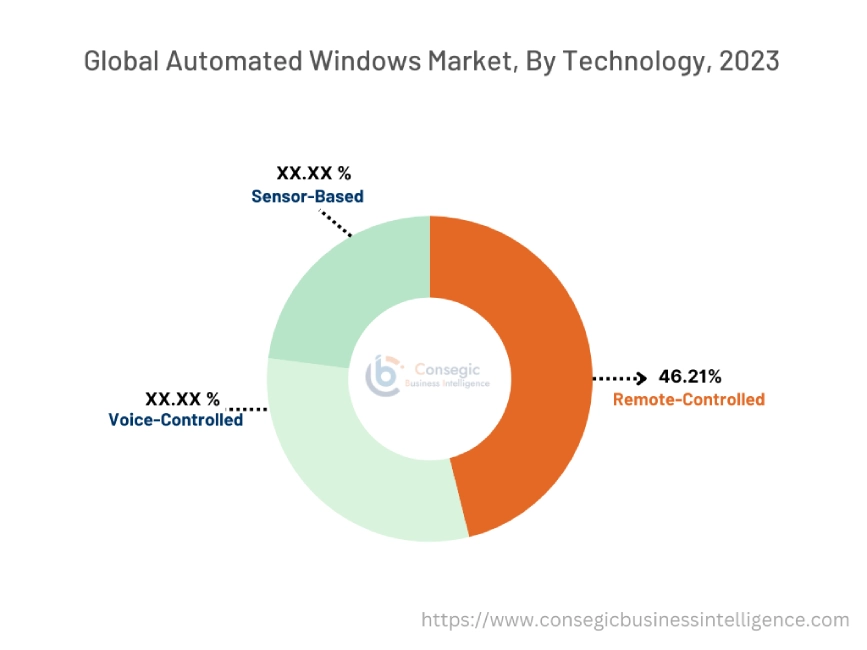
By End-User:
Based on the end user, the market is segmented into residential, commercial, industrial, and others.
Trends in the End User:
- The rising adoption of smart windows in manufacturing and storage facilities to enhance energy management by regulating the indoor environment is driving the automated windows market trends.
- The trend towards integration of smart windows with building management systems (BMS) for better control, energy management, and monitoring across large commercial properties is driving the market progress.
The residential segment accounted for the largest revenue share in the year 2024 and is anticipated to register the fastest CAGR during the forecast period.
- The windows reflect a significant amount of sunlight, particularly infrared radiation, preventing excessive heat from entering the home in summer is driving the automated windows market share.
- Additionally, the key advantages of smart windows in residential buildings include enhanced energy efficiency, adjustable privacy and light control, and improved comfort.
- Further, rapid urbanization as well as increasing adoption of smart home solutions in residential buildings is driving the automated windows market share.
- For instance, in April 2022, JELD-WEN introduced a new line of Auraline composite windows and patio doors. Designed to fill a significant need for home building products, offering a creative solution for the increasing sustainable building material.
- Thus, as per the market analysis, rapid urbanization as well as increasing adoption of smart home solutions is driving the market progress.
Regional Analysis:
The regions covered are North America, Europe, Asia Pacific, Middle East and Africa, and Latin America.
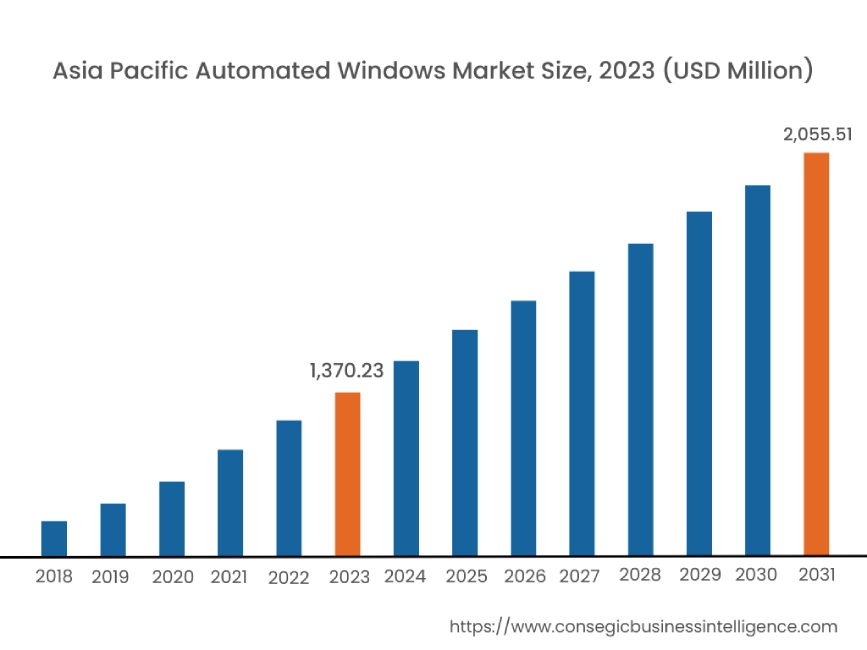
Asia Pacific region was valued at USD 1,594.40 Million in 2024. Moreover, it is projected to grow by USD 1,642.52 Million in 2025 and reach over USD 2,340.02 Million by 2032. Out of this, China accounted for the maximum revenue share of 35.90%. The market is mainly driven by urbanization, economic development, and increasing knowledge about energy efficiency. Furthermore, factors including rising investment in smart infrastructure and real estate projects are projected to drive the market progress in Asia Pacific region during the forecast period.
- For instance, in October 2021, Saint-Gobain India launched a unique 'Myhome' brand store in Mumbai. The product portfolio includes Shower Cubicles, Windows, Kitchen Shutters, and more. Additionally, India saw a rise in the housing industry with a 29% surge in 2021 due to a rise in property registrations, and homeowners are eager to utilize innovative and personalized solutions.
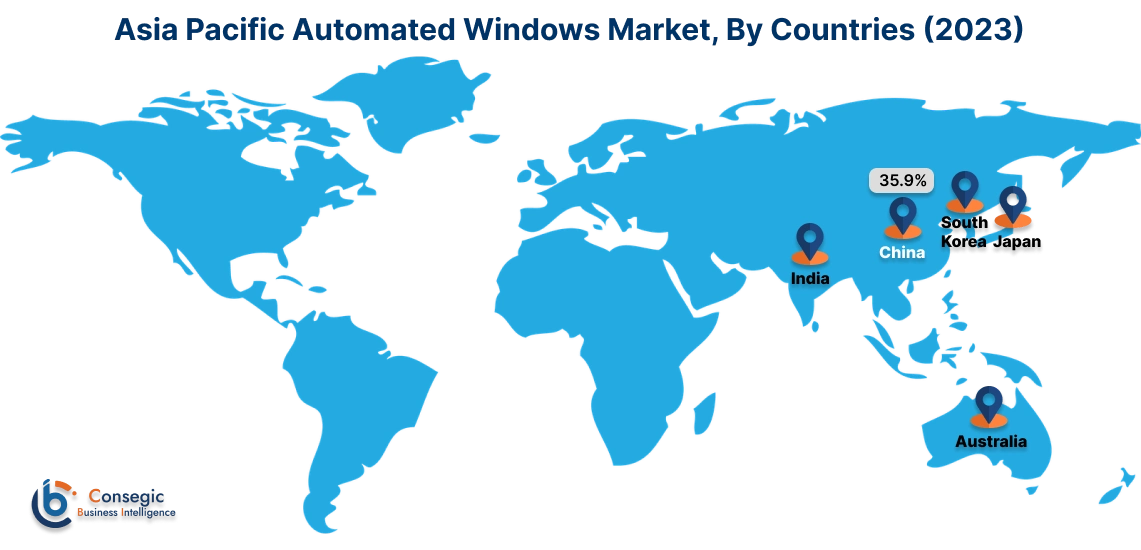
North America is estimated to reach over USD 2,424.60 Million by 2032 from a value of USD 1,706.61 Million in 2024 and is projected to grow by USD 1,753.28 Million in 2025. The North American region's widespread adoption of intelligent systems along with well-developed infrastructure offer lucrative prospects for the market. Additionally, the strong emphasis on energy efficiency as well as sustainability is driving the market progress.
- For instance, in June 2023, Johnson Controls launched automated windows systems designed to better integrate with building management systems. These windows are currently being installed across various high-profile projects in North America such as office buildings and smart campuses noted the press release. The main aim of this technology is to improve energy efficiency and ensure a seamless user experience through advanced automation and connectivity.
The regional evaluation depicts that the strong emphasis on urbanization, increased infrastructure investment, and a growing emphasis on luxurious and energy-efficient building solutions are driving the market in Europe. Additionally, the key factor driving the market is the growing focus on smart cities and sustainable development is propelling the market adoption in the Middle East and African region. Further, the increasing infrastructure projects such as residential, commercial, and hospitality projects are paving the way for the progress of the market in Latin America region.
Top Key Players & Market Share Insights:
The global automated windows market is highly competitive with major players providing windows to the national and international markets. Key players are adopting several strategies in research and development (R&D), product innovation, and end user launches to hold a strong position in the automated windows industry. Key players in the automated windows market include-
- Velux Group (Denmark)
- SageGlass (US)
- ASSA ABLOY (Sweden)
- Nabtesco Corporation (Japan)
- Allegion Plc (Ireland)
- Sky-Frame (Switzerland)
- Somfy (France)
- Breezway (Australia)
- Colt International (U.K.)
- D+H Mechatronic (Germany)
Recent Industry Developments :
Product launches
- In January 2024, Pella Corporation unveiled current design trends, which play a key role in personalizing living spaces. The proliferation of environmentally friendly construction techniques and materials, as well as expert workmanship and efficient windows and doors, enhance the home experience with efficiency.
- In June 2023, Guardian Glass released a new product line featuring electrochromic technology that allows windows to transition from transparent to tinted based on light conditions. This product is designed for both residential and commercial applications, promoting energy savings and occupant comfort.
Fundings
- In May 2024, Skyline Windows revealed investment from Schueco International, a worldwide specialist in windows, doors, and façade solutions. Schueco is acquiring a small share of ownership in Skyline and is planning to become a distributor of Schueco's products in North America.
Automated Windows Market Report Insights :
| Report Attributes | Report Details |
| Study Timeline | 2019-2032 |
| Market Size in 2032 | USD 7,831.41 Million |
| CAGR (2025-2032) | 4.73% |
| By Type |
|
| By Technology |
|
| By End-User |
|
| By Region |
|
| Key Players |
|
| North America | U.S. Canada Mexico |
| Europe | U.K. Germany France Spain Italy Russia Benelux Rest of Europe |
| APAC | China South Korea Japan India Australia ASEAN Rest of Asia-Pacific |
| Middle East and Africa | GCC Turkey South Africa Rest of MEA |
| LATAM | Brazil Argentina Chile Rest of LATAM |
| Report Coverage |
|
Key Questions Answered in the Report
How big is the automated windows market? +
The automated windows market size is estimated to reach over USD 7,831.41 Million by 2032 from a value of USD 5,528.82 Million in 2024 and is projected to grow by USD 5,678.58 Million in 2025, growing at a CAGR of 4.73% from 2025 to 2032.
Which segmentation details are covered in the automated windows report? +
The automated windows report includes specific segmentation details for type, technology, end user, and regions.
Who are the major players in the automated windows market? +
The key participants in the automated windows market are Velux Group (Denmark), SageGlass (US), Somfy (France), Breezway (Australia), Colt International (U.K.), D+H Mechatronic (Germany), ASSA ABLOY (Sweden), Nabtesco Corporation (Japan), Allegion Plc (Ireland), Sky-Frame (Switzerland), and others.
Which is the fastest segment anticipated to impact the market growth? +
In the automated windows market, the voice-controlled technology is the fastest-growing segment during the forecast period due to proliferation of IoT technologies.
What are the key trends in the automated windows market? +
The automated windows market is being shaped by several key trends including integration of smart windows with building management systems (BMS) for better control, energy management, and monitoring across large commercial properties as well as adoption of sensor-based systems to optimize energy usage and others are the key trends driving the market.
